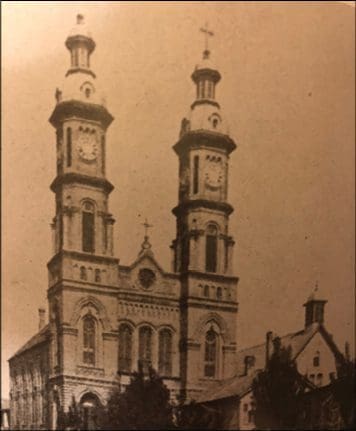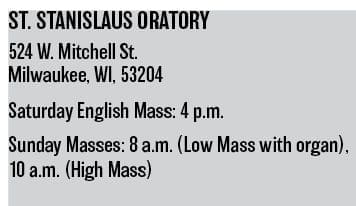
Top and above: St. Stanislaus has been serving Milwaukee since 1866.
Since 1872, the towering twin spires of St. Stanislaus Church have kept careful watch over Milwaukee’s South Side. Widely regarded as an architectural treasure, the Cream City brick edifice designed by Leonard Schmittner also serves as one of the crown jewels of the city’s Polish Catholic identity.
Today, the parish represents an intersection between the past and the present: within those walls, which have sheltered so many generations of the faithful, there is a blending of old tradition and youthful vigor. The echoes of ancient Latin prayers mingle with the cries of newborn babies. Delicate chapel veils are worn by young girls and women stooped with age. Recent restoration efforts have created a worship space that gleams like new but also recalls a certain sacredness from eras passed.
And those old tower bells, hung in 1882, still toll before and after each daily Mass — the heartbeat of this parish, still going strong.
Believed to be the oldest continually operating Polish Catholic parish in the United States, St. Stanislaus was founded in 1866 by 30 immigrant families who pooled their funds to purchase a small brick church from a German Lutheran congregation on the corner of Fifth and Mineral streets. By the 1880s, St. Stanislaus was serving 3,000 people, baptizing between 300 and 600 babies each year. Interior renovations took place in the early part of the 20th century, when marble panels, side altars and an organ were added, and the church was often referred to as a “cathedral” for its breathtaking ornamentation, a physical manifestation of the faith of its founding parishioners, for whom the church existed at the center of community life.
But the parish, by 2007, had reached a critical crossroads, and then-Archbishop Timothy Dolan had a difficult decision to make. Changing demographics in the region and the construction of the highway had taken a toll on parish membership; St. Stanislaus’ population of believers had dwindled to an unsustainable number.
It was at this same time that another Catholic community in the archdiocese faced the loss of its home. Since the promulgation of the Mass of Pope Paul VI in 1969, now regarded as the Ordinary Form of the Mass, there has still existed a group of Catholics who prefer to worship according to the traditional Latin Liturgy, now regarded as the Extraordinary Form. The Latin Mass community was renting space from St. Mary Help of Christians in West Allis. Before that, they had worshipped in a variety of locations, including the Cousins Center and Marchese’s Dance Hall in Lisbon. But by 2007, St. Mary Help of Christians was slated to close, and the Latin Mass community was facing displacement.
The landmark church on Historic Mitchell Street had the space, and the Latin Mass community had the people. It was therefore decided, in light of Pope Benedict XVI’s 2007 motu proprio Summorum Pontificum, which allowed for more widespread use of the 1962 missal, that St. Stanislaus would be given over to the care of the Institute of Christ the King, Sovereign Priest, a century-old order based in Florence that is dedicated to the use of the Extraordinary Form.
“We have a parish life now,” said Lisa Lau, a St. Stanislaus parishioner who has been a part of the Latin Mass community for several decades. “Any time we had a priest and the Holy Sacrifice of the Mass, we had a place — but now we have a parish, and we have a parish life, and we have parish family. To see the family grow because you’re in one place is just exhilarating.”
And grow it has. Sunday Mass attendance increased 63 percent between 2007 and 2014, said parish administrator Canon Benoit Jayr, who has been at St. Stanislaus since 2011. “Last Sunday, we had 691 people attending Mass,” he reported. Though parishioners span all ages, many are comprised of large, young families.

By the 1880s, St. Stanislaus was serving 3,000 families and baptizing more than 300 babies a year. (Submitted photo)
“It’s like walking into a garden of flowers,” said Lau. “There are children everywhere, and it’s beautiful and exciting.”
Many Oratory families hail from all over the archdiocese, as far north as Kohler and as far south as Racine. They share with the founding members of St. Stanislaus a deep devotion to — and willingness to sacrifice for — their spiritual community, said Abbe George Baid, a clerical oblate (similar to a religious brother) with the Institute who has been at St. Stanislaus since 2011.
“I think the faithful today really follow that pattern of the early immigrants here — they see a necessity for a place of worship for their family, so they are motivated and very, very generous — but most are of humble means; they’re your common folk,” said Abbe Baird. The community has not only provided the financial support for the capital campaign that funded the restoration efforts, but they are equally “generous with their time,” he said. “If we need to clean the basement out, we have the help. They also clean the rectory, as a place of community life.”
The St. Stanislaus community is actually comprised of two separate canonical entities — the parish, which owns the church, rectory and school buildings (the latter is leased to St. Anthony School), and the Oratory, or the Latin Mass community, which was canonically established by Archbishop Listecki in 2016. “But this (distinction) is just on paper,” said Canon Jayr, who is the administrator for both the parish and the rector for the Oratory. The parish has an English Mass of anticipation on Saturday evening, while the Oratory hosts both a low and high Mass in the Extraordinary Form on Sunday mornings. The parish council is comprised of members from both liturgies.
Canon Jayr attributes the large number of attendees at the Sunday Latin Masses to the rite’s “missionary impact.” This has certainly been true for Steve and Julie Badal and their four sons, who make the 35-minute commute from their home in Oconomowoc every week. Formerly Anglican, the Badals discerned a call to become Catholic, but were unsure of where to find the more traditional style of liturgy to which they were accustomed.
“We stumbled onto St. Stan’s,” said Steve. “We instantly fell in love with it. We loved the reverence, the beauty, the language — it was just everything.” He credits the Latin Mass with opening the door for the family to ultimately join the Catholic Church in February.
Abbe Baird is also a convert from Protestant roots. “The rubrics are very clear in the Latin Mass — for me, that structure, that reasoning, was great,” he said. “I just knew this was where I wanted to be.”
Canon Jayr likens the rubrics of the Latin Mass to “a ballet … a kind of choreography” that inspires a sense of awe, and enables the faithful to “absorb the Mass like a sponge.”
It is, agreed Lau, “a silent holiness” that is, at the same time, “very loud.”
“There are no distractions — I think that’s the best way to put it,” she said. “You walk in, and there is no question that the focus is on God. It is everything filled with God.”
“I think young people are attracted to (the Latin Mass) because it’s a reference, it’s something stable,” said Canon Jayr. “It’s something that is not improvised. And in this world, always moving, to have stable beacons is great. In our modern world, we want to understand everything. Maybe our world is sick because we want to rationalize everything. But sometimes it’s good to be — not against the human reason, but to be beyond the human reason.”
